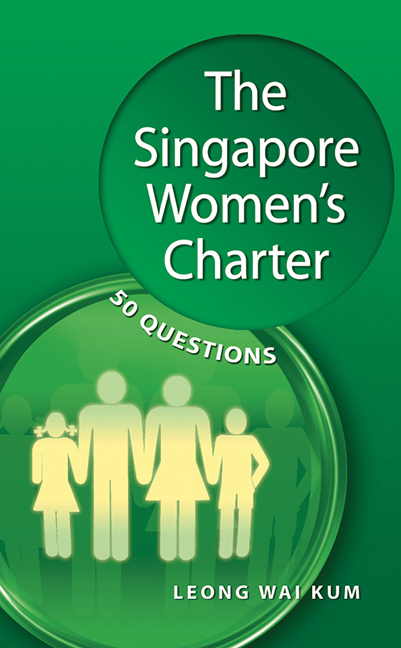Book contents
- Frontmatter
- Contents
- List of Questions
- Foreword
- Preface
- Part I What is the Women's Charter?
- Part II Marriage
- Part III Regulation of Husband-Wife Relationship
- Part IV Regulation of Parent-Child Relationship
- Part V Violence in the Family
- Part VI Divorce and the Process
- Part VII Maintenance
- Part VIII Division of Matrimonial Assets
- Part IX Muslims
- Epilogue
- References
- Index
- About the Author
Part VI - Divorce and the Process
Published online by Cambridge University Press: 21 October 2015
- Frontmatter
- Contents
- List of Questions
- Foreword
- Preface
- Part I What is the Women's Charter?
- Part II Marriage
- Part III Regulation of Husband-Wife Relationship
- Part IV Regulation of Parent-Child Relationship
- Part V Violence in the Family
- Part VI Divorce and the Process
- Part VII Maintenance
- Part VIII Division of Matrimonial Assets
- Part IX Muslims
- Epilogue
- References
- Index
- About the Author
Summary
When can a husband or wife seek divorce?
The right way for any person to view divorce is that it offers relief where nothing else works. The law accordingly offers divorce as relief to unhappily married persons but this relief is rightly available only as the last resort after community resources have been tried and the marital relationship is still unable to heal.
When a married couple encounters difficulties in their relationship, the law continues to support this relationship through various provisions in the Women's Charter. Family Court officials who come into contact with the two parties will continue to remind them of the social services available in Singapore to help them work out their problems so their marriage can possibly continue. It is only when the married couple has reached a stage where it is no longer reasonable to expect them to continue in their marriage that the law offers them the option to end their marriage.
Divorce should not be offered too easily or liberally as this will undermine the institution of marriage. Thus the law of divorce requires a husband or wife to prove that his or her marriage has broken down irretrievably. Further, unless there are exceptional circumstances, a divorce application cannot be made within the first three years of marriage. This restriction aims to ensure that all persons regard marriage with appropriate consideration. No one should rush irresponsibly in or out of marriage. This also means that when there are difficulties in a marital relationship, divorce should not be resorted to until the parties have worked hard at reconciliation and given themselves the time to overcome what could be temporary difficulties. Where, however, divorce is the only way out, the divorce law and processes in the Women's Charter are designed to minimize bitterness, distress and humiliation experienced by the parties, and to achieve a harmonious resolution of the most painful dispute anyone can experience in the course of their lives.
How does the law of divorce relate with the law regulating the relationship between husband and wife?
Balance
The availability of divorce is not, in itself, a threat to the institution of marriage. When a couple has truly come to the end of the line, divorce is not necessarily wrong. What is wrong may be for them to divorce before they have reached the end of the line.
- Type
- Chapter
- Information
- The Singapore Women's Charter50 Questions, pp. 65 - 84Publisher: ISEAS–Yusof Ishak InstitutePrint publication year: 2011



